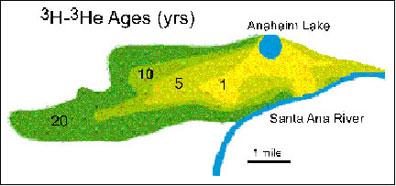The increasing national and international demand for water has led to increasing reliance on subsurface storage, both for naturally and artificially recharged water. This increased reliance on the groundwater in concert with the strict regulation on water quality has led to a need by water managers and regulators to understand:
- How much and on what time scales groundwater can be recharged and withdrawn in specific sub-basins,
- Groundwater flow fields at both recharge and basin scales,
- Water quality impacts of recharge water storage and recovery in a subsurface that is bio-geochemically active,
- How changes in management practices have and will affect water quality, and
- Future distributions of contaminants in the subsurface.
Characterization of mean groundwater age and recharge temperature through the use of noble gas techniques provides information that is relevant to answering these questions and that is not accessible through traditional hydrogeologic approaches.
LLNL has developed a noble gas mass spectrometry facility that houses a state-of-the-art water-gas separation manifold and mass spectrometry system designed specifically for high throughput of groundwater samples. The fully automated, computer-controlled manifold system allows analysis of the full suite of noble gases (3He/4He, He, Ne, Ar, Kr, and Xe concentrations), along with low level tritium for reporting of derived quantities that include tritium/helium-3 groundwater age, noble gas recharge temperature, and dissolved excess air concentration. This system represents a capability for characterizing groundwater recharge conditions by dissolved gas analysis that is unmatched by any other laboratory. Construction of this facility was funded by LLNL. The facility is staffed by Ph.D. scientists with cutting-edge expertise in the measurement and interpretation of noble gases and tritium in groundwater.
The LLNL Groundwater Noble Gas Mass Spectrometry Facility and Capability offers:
- Less model-dependent than tritium age dating: Traditional tritium age-dating is confounded by mixing between old tritium-dead water and young tritiated water, and requires modeling, assumptions or independent estimates of the mixing ratio to convert measured tritium activity into a groundwater age. When mixing is ignored, as it often is, tritium alone can overestimate the mean age of the modern (less than 50 year) age component. Tritium/helium-3 age dating is not affected by dilution with old (or pre-modern) groundwater and yields both the mean age of the modern age component and, when compared with tritium in precipitation curves, the mixing ratio between modern and pre-modern water.
- High throughput and rapid turn-around: The fully automated, computer-controlled manifold system allows for rapid analysis of the full suite of noble gases, and allows determination of tritium through helium-3 accumulation.
- Full elemental analysis of all noble gases: Accurate analysis of dissolved Neon allows determination of excess air concentration; analysis of the heavy noble gases, Krypton and Xenon allows a robust calculation of the noble gas recharge temperature; an estimate of accumulated radiogenic 4-Helium can be made from total dissolved helium.
- Expertise in interpretation of groundwater data: The natural and non-natural processes that impart a dissolved gas composition to recharging groundwater are complex and variable. Groundwater samples may or may not contain tritium above the method detection limit. Natural or non-natural processes may incorporate significant excess air concentrations or conversely strip groundwater of dissolved gases. In-situ biological processes may alter dissolved gas composition. Thus no simple algorithm exists that will produce reliable groundwater ages for all samples. LLNL scientists carry out ongoing collaborative research on interpretation of dissolved gas composition for groundwater applications and continue to gain experience with sample analysis, data analysis, and derived results interpretation.
- Expertise in the use of noble gas tracers: Isotopically enriched noble gases are inexpensive, commercially available, and non-toxic, allowing them to be used as introduced tracers to tag large volumes of recharging water. The ability to use a variety of different isotopes for each element and the low backgrounds in natural waters allows tracing different sources of recharge to a given receptor well at very low mixing ratios and with large dynamic range.
- Supporting capabilities for the characterization of groundwater and surface water gas composition: The facility also provides membrane inlet mass spectrometry for rapid determination of major and minor gases in groundwater, including argon, nitrogen, oxygen, carbon dioxide and methane.
- Supporting capabilities for isotopic characterization of groundwater and groundwater contaminants. The facility is closely integrated with a stable isotope mass spectrometry laboratory capable of providing supporting information for groundwater transport studies, including stable isotopic composition of water, nitrate, and carbon. The nitrate isotopic capability is state of the art, and uses the microbial method to determine the isotopic composition of both nitrate nitrogen and oxygen in small volume samples containing very low concentrations of nitrate.



